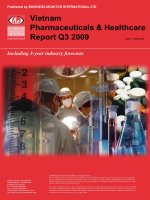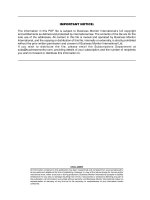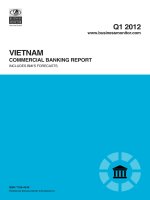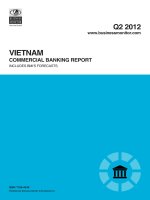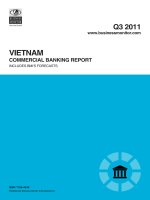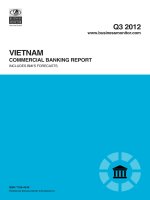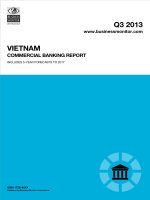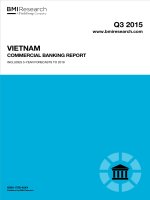Vietnam pharmaceuticals healthcare report q3 2012
Bạn đang xem bản rút gọn của tài liệu. Xem và tải ngay bản đầy đủ của tài liệu tại đây (929.68 KB, 108 trang )
Q3 2012
www.businessmonitor.com
PHARMACEUTICALS & HEALTHCARE REPORT
ISSN 1748-2305
Published by Business Monitor International Ltd.
VIETNAM
INCLUDES BMI'S FORECASTS
Business Monitor International
85 Queen Victoria Street
London
EC4V 4AB
UK
Tel: +44 (0) 20 7248 0468
Fax: +44 (0) 20 7248 0467
email:
web:
© 2012 Business Monitor International.
All rights reserved.
All information contained in this publication is
copyrighted in the name of Business Monitor
International, and as such no part of this publication
may be reproduced, repackaged, redistributed, resold in
whole or in any part, or used in any form or by any
means graphic, electronic or mechanical, including
photocopying, recording, taping, or by information
storage or retrieval, or by any other means, without the
express written consent of the publisher.
DISCLAIMER
All information contained in this publication has been researched and compiled from sources believed to be accurate and reliable at the time of
publishing. However, in view of the natural scope for human and/or mechanical error, either at source or during production, Business Monitor
International accepts no liability whatsoever for any loss or damage resulting from errors, inaccuracies or omissions affecting any part of the
publication. All information is provided without warranty, and Business Monitor International makes no representation of warranty of any kind as
to the accuracy or completeness of any information hereto contained.
VIETNAM
PHARMACEUTICALS &
HEALTHCARE
REPORT Q3 2012
INCLUDES 10-YEAR FORECASTS TO 2021
Part of BMI’s Industry Survey & Forecasts Series
Published by: Business Monitor International
Copy deadline: June 2012
Vietnam Pharmaceuticals & Healthcare Report Q3 2012
© Business Monitor International Ltd Page 2
Vietnam Pharmaceuticals & Healthcare Report Q3 2012
© Business Monitor International Ltd Page 3
CONTENTS
Executive Summary 6
SWOT Analysis 8
Vietnam Pharmaceutical And Healthcare Industry SWOT 8
Vietnam Political SWOT 9
Vietnam Economic SWOT 10
Vietnam Business Environment SWOT 11
Pharmaceutical Risk/Reward Ratings 12
Table: Asia Pacific Pharmaceutical Risk/Reward Ratings, Q312 12
Rewards 13
Risks 13
Vietnam – Market Summary 15
Regulatory Regime 17
Pharmaceutical Advertising 18
Intellectual Property Environment 19
IP Shortcomings 19
Counterfeit Drugs 21
Pricing Regime 22
Price Spikes 24
Reimbursement Regime 25
Pricing And Reimbursement Developments 26
Industry Trends And Developments 28
Epidemiology 28
Communicable Diseases 29
HIV/AIDS 30
Non-Communicable Diseases 31
Healthcare Financing 32
Hospital Sector 32
Private Healthcare Sector 34
Healthcare Insurance 35
Healthcare And Pharmaceutical Reform 36
Foreign Partnerships 38
Research & Development 38
Biotechnology Sector 39
Vaccines 40
Clinical Trials 42
Medical Device Market 42
Industry Forecast Scenario 45
Overall Market Forecast 45
Table: Pharmaceutical Sales Indicators 2008-2016 47
Healthcare Market Forecast 48
Table: Healthcare Expenditure Indicators 2008-2016 49
Table: Healthcare Governmental Indicators 2008-2016 50
Table: Healthcare Private Indicators 2008-2016 50
Vietnam Pharmaceuticals & Healthcare Report Q3 2012
© Business Monitor International Ltd Page 4
Key Growth Factors – Macroeconomic 52
Prescription Drug Market Forecast 56
Table: Prescription Drug Sales Indicators 2008-2016 58
Patented Drug Market Forecast 59
Table: Patented Drug Market Indicators 2008-2016 60
Generic Drug Market Forecast 61
Table: Generic Drug Sales Indicators 2008-2016 62
OTC Medicine Market Forecast 63
Table: OTC Medicine Sales Indicators 2008-2016 64
Pharmaceutical Trade Forecast 65
Table: Exports and Imports Indicators 2008-2016 67
Medical Device Market Forecast 68
Table: Medical Devices Sales Indicators 2008-2016 69
Other Healthcare Data Forecasts 70
Key Risks To BMI’s Forecast Scenario 71
Competitive Landscape 72
Pharmaceutical Industry 72
Domestic Pharmaceutical Sector 73
Foreign Pharmaceutical Sector 75
Recent Pharmaceutical Industry News 76
Traditional Medicines 79
Pharmaceutical Distribution 80
Pharmaceutical Retail Sector 80
Table: Key Aspects Of Good Pharmacy Practice In Developing Countries 82
Company Profiles 83
Local Companies 83
Vietnam Pharmaceutical Corporation (Vinapharm) 83
Vietnam OPV Pharmaceutical Co 85
Vietnam Pharmaceutical Joint Stock Company (Ampharco) 87
Vidipha Central Pharmaceutical Joint Stock Company 89
Multinational Companies 90
Pfizer 90
Sanofi 91
Novartis 93
Merck & Co 94
GlaxoSmithKline 96
Demographic Outlook 97
Table: Vietnam's Population By Age Group, 1990-2020 ('000) 98
Table: Vietnam's Population By Age Group, 1990-2020 (% of total) 99
Table: Vietnam's Key Population Ratios, 1990-2020 100
Table: Vietnam's Rural And Urban Population, 1990-2020 100
Glossary 101
BMI Methodology 103
How We Generate Our Pharmaceutical Industry Forecasts 103
Pharmaceuticals Risk/Reward Ratings Methodology 104
Ratings Overview 104
Table: Pharmaceutical Business Environment Indicators 105
Weighting 106
Vietnam Pharmaceuticals & Healthcare Report Q3 2012
© Business Monitor International Ltd Page 5
Table: Weighting Of Components 106
Sources 106
Vietnam Pharmaceuticals & Healthcare Report Q3 2012
© Business Monitor International Ltd Page 6
Executive Summary
BMI View: Vietnam continues to be viewed as a promising, but risky, commercial proposition. We
envisage continued involvement of multinational companies in both its pharmaceutical and healthcare
markets, although the country’s longer term potential will continue to be clouded by the lacking
intellectual property (IP) climate and the prevalence of corruption, among other issues.
Headline Expenditure Projections
Pharmaceuticals: VND39,003bn (US$1.89bn) in 2011 to VND45,284bn (US$2.15bn) in 2012;
+16.1% in local currency terms and +14.0% in US dollar terms. Forecast unchanged from
Q312.
Healthcare: VND157, 234bn (US$7.61bn) in 2011 to VND180,892bn (US$8.60bn) in 2012;
+15.0% in local currency terms and +13.0% in US dollar terms. Forecast broadly unchanged
from Q312, despite lowering of historical data.
Medical devices: VND15,137bn (US$733mn) in 2011 to VND17,026bn (US$809mn) in 2012;
+12.5% in local currency terms and +10.4% in US dollar terms. Forecast slightly lower from
Q312, party on account of changed historical data.
Risk/Reward Rating: In the current quarter’s regional Risk/Reward Rating (RRR), Vietnam scores 40.9,
which is lower in relation to Q212, but still ranks the country 14th out of the 18 key markets surveyed in
Asia Pacific. Globally, Vietnam is 72nd out of 95 countries assessed. Its longer-term attractiveness is
clouded by low per capita spending and also by the risky operating environment, complete with
widespread prevalence of counterfeit drugs, despite the benefits expected to be brought about by the
country’s economic development.
Key Trends And Developments
In May 2012, a local subsidiary of Japanese Hisamitsu Pharmaceutical Co Inc inaugurated a
new factory. The investment in the plant, located in Dong Nai province’s Bien Hoa Industrial
Park, topped US$16.84mn. The factory – run by Hisamitsu Vietnam Pharmaceutical Co Ltd –
will produce Salonpas pain-relief patches, as the company responds to increased demand for the
product, both locally and regionally.
In April 2012, the Drug Administration of Vietnam (DAV) stated that it will heavily fine
organisations that violate medicine price regulations from June 2012. New price regulations have
been established by the ministries of health, finance and industry and trade. According to the
inter-department circular, traders will be wholly responsible for their product's original, listed
and selling prices, which will be strictly monitored by the price management authorities.
Vietnam Pharmaceuticals & Healthcare Report Q3 2012
© Business Monitor International Ltd Page 7
Drugmakers will have to record both import prices and original prices of foreign-made as well as
domestically-produced drugs. They also need to register the wholesale and retail prices offered
to the DAV, the Ministry of Health and local health centres.
The presence of counterfeit drugs will impede the eradication of malaria, as well as other high-
prevalence diseases in the country. According to the US National Institutes of Health, over a
third of malaria drugs that were examined in South East Asia, including Vietnam, were
counterfeits, with 30% of the 1,437-drug sample failing a test of their pharmaceutical
ingredients. While we believe it is highly unlikely that counterfeit drug manufacturing will cease
completely due to its lucrative nature, it is our view that the authorities have to establish
stringent regulatory measures to prevent the use and distribution of fake drug in their countries.
BMI Economic View: We remain positive about Vietnam's growth prospects over the next 10 years, as
seen in our firm growth projections, which average 7.1% over 2012-2021. This is because we expect a
shift in government policy to accommodate the effects of a less conducive global environment and a need
to avoid overheating tendencies such as high inflation and a large trade deficit, which have characterised
the Vietnamese economy in recent years.
BMI Political View: The attractions of Vietnam to foreign, as well as domestic, investors are clear: a
large and young population, and the country open to foreign influences after decades of ineffective
ideological indoctrination. Vietnam has enjoyed a growing inflow of foreign direct investment (FDI) into
its fledgling manufacturing sector in recent years, as its accession to the WTO in 2007 and low labour
costs have made it an attractive outsourcing destination for various producers. The development of the
foreign-owned manufacturing sector has been spearheaded by Japanese, South Korean and Taiwanese
firms, which have become increasingly wary of rising costs of labour on the Chinese mainland, as well as
the risks of becoming overly dependent on Beijing in their supply chains. We expect the country to
continue pursuing similar policies, although we caution that Vietnam faces pressures for democratisation.
Vietnam Pharmaceuticals & Healthcare Report Q3 2012
© Business Monitor International Ltd Page 8
SWOT Analysis
Vietnam Pharmaceutical And Healthcare Industry SWOT
Strengths
Significant growth potential, given a large and growing population.
The government’s commitment to developing the health sector.
Sizeable local generic drugs sector, which is being encouraged by the government.
Strong traditional medicines segment with potential to improve the non-prescription
drugs market in the longer term, as long as sufficient investment in extraction
technologies can be found.
Weaknesses
One of the least developed pharmaceutical markets in Asia, with low per capita
spending on drugs.
Counterfeit drugs account for a significant amount of market consumption.
No bioequivalence requirement in place for locally made generic medicines.
Little distinction made between prescription and over-the-counter drugs, with most
medicines available without a prescription.
Complex drug pricing policy biased towards local drug producers.
Import-reliant market, especially in terms of high-tech products and active
pharmaceutical ingredients, which makes it vulnerable to currency movements.
Underdeveloped primary care services and a shortage of trained pharmacists is
continuing to hamper access to medicines and product market penetration.
Population concentrated in rural, rather than urban areas, preventing access to
modern drugs and encouraging dependence upon traditional medicines.
Opportunities
The Association of South East Asian Nations (ASEAN) harmonisation initiative,
including the adoption of Western regulatory standards such as International
Conference on Harmonisation and World Health Organization guidelines.
Introduction of five-year exclusivity for clinical dossier data encouraging research-
based multinationals.
If investment can be found for technological improvements, then there is great
potential in the traditional Chinese medicine market, in addition to fledging
biotechnology.
Full WTO membership improving the trading climate and potentially, in the longer
term, redressing pharmaceutical trade issues.
Requirement for domestic companies to comply with international good
manufacturing practices should boost exports.
Threats
Government resistance to aligning patent law fully with international standards
deterring multinational sector expansion.
Need to resolve infrastructural and power supply issues, as well as higher education
provision, before higher levels of foreign direct investment can be expected.
The government is increasingly interfering in the industry, protecting indigenous firms
through the use of legal trade barriers, which will affect competitiveness.
Pharmaceutical price inflation threatens to put medicines out of reach of poor and
therefore limit market volume growth.
Legalisation of parallel imports negatively impacting performance of patented drugs.
New health insurance legislation decreasing patients’ access to medicines.
Vietnam Pharmaceuticals & Healthcare Report Q3 2012
© Business Monitor International Ltd Page 9
Vietnam Political SWOT
Strengths
The Communist Party of Vietnam remains committed to market-oriented reforms and
we do not expect major shifts in policy direction over the next five years. The one-party
system is generally conducive to short-term political stability.
Relations with the US have witnessed a marked improvement, and Washington sees
Hanoi as a potential geopolitical ally in South East Asia.
Weaknesses
Corruption among government officials poses a major threat to the legitimacy of the
ruling Communist Party.
There is increasing (albeit still limited) public dissatisfaction with the leadership's tight
control over political dissent.
Opportunities
The government recognises the threat corruption poses to its legitimacy, and has acted
to clamp down on graft among party officials.
Vietnam has allowed legislators to become more vocal in criticising government
policies. This is opening up opportunities for more checks and balances within the one-
party system.
Threats
Macroeconomic instabilities in 2012 are likely to weigh on public acceptance of the one-
party system, and street demonstrations to protest economic conditions could develop
into a full-on challenge of undemocractic rule.
Although strong domestic control will ensure little change to Vietnam's political scene in
the next few years, over the longer term, the one-party-state will probably be
unsustainable.
Relations with China have deteriorated over recent years due to Beijing's more
assertive stance over disputed islands in the South China Sea and domestic criticism of
a large Chinese investment into a bauxite mining project in the central highlands, which
could potentially cause wide-scale environmental damage.
Vietnam Pharmaceuticals & Healthcare Report Q3 2012
© Business Monitor International Ltd Page 10
Vietnam Economic SWOT
Strengths
Vietnam has been one of the fastest-growing economies in Asia in recent years, with
GDP growth averaging 7.1% annually between 2000 and 2011.
The economic boom has lifted many Vietnamese out of poverty, with the official poverty
rate in the country falling from 58% in 1993 to 14.0% in 2010.
Weaknesses
Vietnam still suffers from substantial trade, current account and fiscal deficits, leaving
the economy vulnerable to global economic uncertainties in 2012. The fiscal deficit is
dominated by substantial spending on social subsidies that could be difficult to
withdraw.
The heavily-managed and weak currency reduces incentives to improve quality of
exports, and also keeps import costs high, contributing to inflationary pressures.
Opportunities
WTO membership has given Vietnam access to both foreign markets and capital, while
making Vietnamese enterprises stronger through increased competition.
The government will in spite of the current macroeconomic woes, continue to move
forward with market reforms, including privatisation of state-owned enterprises, and
liberalising the banking sector.
Urbanisation will continue to be a long-term growth driver. The UN forecasts the urban
population rising from 29% of the population to more than 50% by the early 2040s.
Threats
Inflation and deficit concerns have caused some investors to re-assess their hitherto
upbeat view of Vietnam. If the government focuses too much on stimulating growth and
fails to root out inflationary pressure, it risks prolonging macroeconomic instability,
which could lead to a potential crisis.
Prolonged macroeconomic instability could prompt the authorities to put reforms on hold
as they struggle to stabilise the economy.
Vietnam Pharmaceuticals & Healthcare Report Q3 2012
© Business Monitor International Ltd Page 11
Vietnam Business Environment SWOT
Strengths
Vietnam has a large, skilled and low-cost workforce that has made the country attractive
to foreign investors.
Vietnam's location – its proximity to China and South East Asia, and its good sea links –
makes it a good base for foreign companies to export to the rest of Asia, and beyond.
Weaknesses
Vietnam's infrastructure is still weak. Roads, railways and ports are inadequate to cope
with the country's economic growth and links with the outside world.
Vietnam remains one of the world's most corrupt countries. According to Transparency
International's 2011 Corruption Perceptions Index, Vietnam ranks 112 out of 183
countries.
Opportunities
Vietnam is increasingly attracting investment from key Asian economies, such as
Japan, South Korea and Taiwan. This offers the possibility of the transfer of high-tech
skills and know-how.
Vietnam is pressing ahead with the privatisation of state-owned enterprises and the
liberalisation of the banking sector. This should offer foreign investors new entry points.
Threats
Ongoing trade disputes with the US, and the general threat of American protectionism,
which will remain a concern.
Labour unrest remains a lingering threat. A failure by the authorities to boost skills
levels could leave Vietnam a second-rate economy for an indefinite period.
Vietnam Pharmaceuticals & Healthcare Report Q3 2012
© Business Monitor International Ltd Page 12
Pharmaceutical Risk/Reward Ratings
Globally speaking, the Asia Pacific region remains as the second most attractive for multinational drugmakers.
It closely follows Western Europe and is expected to increase its lead over Eastern Europe due to its improving
rewards profile – given the more favourable economic and demographic factors. In our Pharmaceuticals
Risk/Reward Ratings (RRR) table for Q312, Asia Pacific’s score is lower by one point from the previous
quarter - at 52.7 - which nevertheless remains broadly in line with the global average.
Table: Asia Pacific Pharmaceutical Risk/Reward Ratings, Q312
Rewards Risks
Industry
Rewards
Country
Rewards Rewards
Industry
Risks
Country
Risks Risks
Pharma
RRR
Regional
Rank
Japan 77 63 73 80 77 79 75.5 1
Australia 50 87 59 72 84 77 66.2 2
South Korea 60 67 62 70 69 70 64.9 3
China 67 50 63 67 56 63 62.5 4
Singapore 40 80 50 80 79 80 61.9 5
Taiwan 53 60 55 70 65 68 60.2 6
Hong Kong 47 70 53 67 79 72 60.2 7
Malaysia 50 60 53 70 69 70 59.3 8
New Zealand 30 83 43 60 87 71 54.4 9
India 60 43 56 53 50 52 54.4 10
Indonesia 53 50 53 40 46 42 48.4 11
Thailand 47 47 47 37 58 45 46.1 12
Philippines 43 57 47 43 45 44 45.7 13
Vietnam 43 47 44 40 30 36 40.9 14
Pakistan 40 47 42 33 40 36 39.5 15
Bangladesh 37 43 38 40 36 38 38.3 16
Sri Lanka 30 43 33 40 48 43 37.2 17
Cambodia 33 37 34 30 36 32 33.5 18
Regional
Average 48 57 50 55 59 57 52.7
Scores out of 100, with 100 highest. Source: BMI
Vietnam Pharmaceuticals & Healthcare Report Q3 2012
© Business Monitor International Ltd Page 13
Vietnam maintains its ranking of 14
th
out of 18 key regional markets. Due to a combination of economic
and regulatory drawbacks, Vietnam is a relatively high-risk proposition. Nevertheless, over the forecast
period through to 2021, we expect Vietnam to consolidate its place above countries such as Pakistan and
Bangladesh as the market matures. The key components of Vietnam’s score are:
Rewards
Industry and country rewards scores are
weighted and combined to form the overall
rewards score. Vietnam’s score of 44 has
fallen further below the regional average,
which stands at 50 for the quarter.
Industry Rewards
Vietnam is an attractive market currently
experiencing double-digit growth and,
importantly, we expect this trend to
continue for at least the next five years.
However, very low annual per capita
spending (just US$21 in 2011) and a
relatively small market (US$1.89bn in the
same year) represent distinct drawbacks, which limit the country’s score in this category.
Country Rewards
Vietnam scores poorly because of its large rural population, which lacks access to healthcare providers
such as hospitals, clinics and pharmacies. As a result of the Vietnam war, when 2-5mn people died,
demographics are skewed, so there are many more youths than elderly people. Since old people consume
more medicines, the opportunities for drugmakers in a country with a population of 89mn are fewer than
expected. However, with rapid demographic growth anticipated, there should still be opportunities. By
2021, the population should top 97mn.
Risks
Industry and country risks are weighted and combined to form the overall score for risks. Vietnam’s score
of 36 is among the lowest in the region, indicating substantial risks facing multinationals operating and
wishing to operate in the country. The regional average has remained at 57 for Q312.
Risk/Reward Ratings By Subsector Score
Q312
Source: BMI
Vietnam Pharmaceuticals & Healthcare Report Q3 2012
© Business Monitor International Ltd Page 14
Industry Risks
One of the most obvious drawbacks of the Vietnamese pharmaceutical market is erratic pricing. In 2009,
numerous products saw double-digit price hikes, with some companies raising prices for their drugs twice
in a couple of months. This was partly due to currency depreciation and rises in the cost of imported
active pharmaceutical ingredients (APIs), but is also partly due to poor state monitoring, with this
situation continuing. While a significant obstacle to smaller domestic manufacturers, the upcoming
deadline to adhere to good manufacturing practice (GMP) requirements should benefit foreign firms that
are already accredited.
Country Risks
Vietnam is a stable communist state and therefore scores highly for policy continuity. Its economic
structure, which is characterised by increasing privatisation, is below global standards, but improvements
are expected. Corruption is an issue, as is the sub-standard legal framework and occasional
demonstrations; although we see limited evidence to suggest that a large-scale political uprising could
occur in the short-to-medium term.
Vietnam Pharmaceuticals & Healthcare Report Q3 2012
© Business Monitor International Ltd Page 15
Vietnam – Market Summary
In common with many of its regional
neighbours, the Vietnamese
pharmaceutical market is underdeveloped
and suffers from poor regulatory and
intellectual property (IP) standards, which
have held back foreign investment in the
country. Low-cost, locally produced
generic drugs – as well as counterfeit
products – account for a sizeable
proportion of drug consumption due to low
consumer purchasing power and an under-
funded healthcare system. Uneven and
inadequate public insurance coverage
means that patients are responsible for
financing many of their medical needs,
which in the past has hampered stronger market growth. Consequently, pharmaceutical consumption
represented only 1.6% of Vietnam’s GDP in 2011, with no improvement expected in the coming years as
GDP growth outstrips growth in drug expenditure.
Nevertheless, the membership of the WTO will serve to promote the development of Vietnam’s
pharmaceutical sector as well as to reduce the role of counterfeit trade. The domestic industry,
traditionally characterised by poor manufacturing standards and obsolete facilities, is likely to undergo a
wave of consolidation in the face of rising pressure – and associated costs – on companies to implement
international GMP standards. Additionally, WTO membership will have a positive effect on the sector as
it encourages imports and FDI and improves operational efficiency in what has traditionally been an
overly bureaucratic and less than dynamic industry.
Prescription medicines will remain dominant over the next five years, with the biggest focus on drugs for
the treatment of infectious and chronic diseases. The over-the-counter (OTC) sector has the potential to
be boosted by the re-categorisation of popular traditional medicines, although presently there are no such
plans. In the meantime, market figures will remain distorted by the lack of distinction between
prescription and OTC drugs, with most medicines available without a prescription.
Vietnamese drug makers account for just 40% of the total medicines market, while the country imports
around 90% of the APIs used in drug production. However, capacity is improving gradually, with the
government aiming to ensure that 60% of domestic demand was met by local pharmaceutical companies
during 2010. Local firms have been looking to increase the sophistication of their production facilities
Pharmaceutical Market By Sub-Sector
(US$bn)
2011
Source: Drug Administration of Vietnam (DAV), Vietnam Ministry
of Health, domestic companies, local press, BMI
Vietnam Pharmaceuticals & Healthcare Report Q3 2012
© Business Monitor International Ltd Page 16
and product portfolios. Vinapharm exemplifies this trend, having signed technology transfer agreements
with US and Chinese firms in recent years. At the start of 2005, there were more than 10,000 kinds of
medicines registered for sale in Vietnam and about 60% were produced locally.
Vietnam Pharmaceuticals & Healthcare Report Q3 2012
© Business Monitor International Ltd Page 17
Regulatory Regime
The main regulatory authority in Vietnam is the Ministry of Health (MoH) and its Drug Administration of
Vietnam (DAV), established in 1996. The basis for market regulation is MoH’s Decision No.
1203/BYT/QD, Regulations on Medicine Registration, implemented in 1996. Drug approval times vary
although long delays are the norm, while the MoH has been accused in the past of being susceptible to
lobbying from drugmakers.
For example, in September 2011, the Office of the Central Steering Committee for Anti-Corruption stated
that it had received complaints from eight pharmaceutical firms (Stada Vietnam, S.Pharma,
Agimexpharm, Tipharco, Pymerpharco, Minh Hai Company and Khanh Hoa Pharma Company)
that the chief of the DAV, Truong Quoc Cuong, broke the rules in granting medicine circulation licenses,
drug import licenses and favouring foreign firms. For example, he permitted BV Pharma to import
several tonnes of pseudoephedrine to produce influenza pharmaceutical products, one to two days after
the firm submitted documentation.
Despite noticeable improvements in the past few years, the DAV reported that about 1,600 applications
were awaiting decisions at the end 2010. Additionally, product visa renewals are required by the MoH
every five years, which adds between eight months and one year to the administrative burden.
By 2004, some 7,569 drugs had received registration, according to official figures. By the start of 2005,
more than 10,000 kinds of medicines were registered for sale in Vietnam, with some 6,107 produced
locally and 4,656 medicines sourced from foreign companies. The DAV, however, recently ordered the
immediate withdrawal of several medicines from the market, baomoi.com reported in April 2011. The
recall was issued after the medicines were found to be of substandard quality. Meanwhile, the Hanoi
Department of Health has asked district authorities to monitor medicine manufacturers and cosmetic
producers as well as the implementation of state regulations on addictive medicines trading in the region.
Regulations governing the pharmaceutical industry have traditionally been unclear and often
implemented on a case-by-case basis, representing a market entry barrier to foreign companies.
Nevertheless, some have been able to take advantage of the situation and increase the price of
pharmaceutical products considerably in recent years.
Vietnam’s regulators are facing their greatest challenge due the country’s entrance to the WTO, which
was achieved in January 2007 (full adoption of rules took place in January 2009). Foreign enterprises
have been given the right to open branches in Vietnam and to import medicines directly, although they
will still be barred from distributing their products.
Vietnam Pharmaceuticals & Healthcare Report Q3 2012
© Business Monitor International Ltd Page 18
As part of its membership application, Vietnam also pledged to set import duties at less than 5% for
pharmaceutical products and drug tariffs are expected to average just 2.5% within five years of accession.
Forty-seven pharmaceutical categories that have tariffs of between 10 and 15% were the first to be
targeted in the shake-up, despite strong opposition from the local industry. In addition, foreign companies
have gained the freedom to import and distribute their products in the country as well as to establish local
branch offices.
The liberalised environment caused problems for Vietnam’s small drug production sector, especially as
the government called on firms to adopt GMP standards by the start of 2010. In July 2008, however, the
MoH extended the deadline for domestic producers to obtain GMP certificates to the end of 2010, which
provided some relief to smaller players in particular. It was subsequently revealed that even this extension
could be negotiated.
Distributors, meanwhile, have been slowly applying ISO 9001: 2000 quality management standards. The
MoH, for its part, is also taking action and is developing the distribution network to help improve access
to medicines throughout the country. Official statistics indicate that Vietnam currently has 165 drug
manufacturers, of which 48 have been certified as GMP-compliant.
The authorities issued an order for the removal of two medication drugs – Genzivit Plus syrup in 100ml
strength and the New Cobex tablet – from the market on May 15 2011. The order was issued after the
drugs failed to meet the required safety standards. During tests conducted by health experts, the drugs,
used as vitamin supplements, were found to have insufficient vitamin B12. The department has asked
hospitals, medical clinics and pharmacies to withdraw both the drugs from their shelves.
Pharmaceutical Advertising
Pharmaceutical advertising is restricted in Vietnam. All advertising materials must be registered with the
DAV.
Prescription drugs cannot be advertised directly to consumers, restricting the potential marketplace.
However, these products can be promoted to health officers via qualified representatives of
pharmaceutical companies and through product conferences and health seminars. Foreign firms are
required to obtain permission from a provincial health department before holding a conference and the
department must be made aware of any pharmaceutical displays.
Advertising laws are more liberal for OTCs than for prescription products. Consumer marketing is
permitted via magazines and newspapers as well as leaflets and brochures. The Ministry of Health issues
a list of drugs that can be advertised to consumers through TV, radio and other mass media outlets.
Vietnam Pharmaceuticals & Healthcare Report Q3 2012
© Business Monitor International Ltd Page 19
In September 2011, industrial insiders revealed that a number of doctors were advertising pharmaceutical
products under the guise of medical advice. Many doctors in the country have recommended specific
drugs while answering health questions in local media. This is despite a 1996 decree that says doctors and
medical officials are ban from using their stature to give recommendations in the media.
Intellectual Property Environment
Vietnam’s accession to the WTO was ratified in January 2007 and implemented two years later, The
membership has already resulted in some improvements to the country’s IP regime, after the government
agreed to immediately implement IP guidelines to the standards of the Trade-Related Aspects of
Intellectual Property Rights (TRIPS) agreement.
The government has taken a number of steps to increase IP protection and the country’s patent structures
are already broadly in line with those demanded by the WTO. This includes a 20-year patent term and the
five-year market exclusivity of undisclosed and other test data, which was clarified in September 2006 by
a more detailed decree. The exception to this rule is when an applicant grants a third-party permission to
use its data, such as through a contract manufacturing or partnership agreement, or when a company
generates the data anew. The regulatory authorities, meanwhile, will release protected data only if it is
deemed necessary to protect the public.
However, concerns remain over the policy that exempts local manufacturers of generic medicines from
submitting bioequivalence studies prior to regulatory approval. Foreign research-based industry members
are critical of this lack of strict equivalence requirements, which negatively impacts on patient safety.
IP Shortcomings
Counterfeiting remains a major deterrent for research-based foreign companies, and recently these
problems have escalated given the current economic crisis. Leading the criticism is the Office of the US
Trade Representative (USTR) and the US research-based drug makers’ association Pharmaceutical
Research and Manufacturers of America (PhRMA), with the former leaving Vietnam among its ‘watch’
countries in its 2012 Special 301 submission, a status unchanged since 2004.
In its 2009 version, PhRMA noted improvements in terms of protection against unfair commercial use of
data generated to obtain marketing approval. However, in 2010 and 2011, the association was critical of
the limited progress made in addressing some of the concerns, despite acknowledging the government’s
willingness to consult on proposed reforms. In general, IP enforcement is considered disorganised and
patchy, worsened by the fact that many agencies can independently decide whether to take action or not,
or refer the complaints to another body. In addition, the legal system has little experience of patent
enforcement and interpretation, with guidelines on those issues lacking.
Vietnam Pharmaceuticals & Healthcare Report Q3 2012
© Business Monitor International Ltd Page 20
In the past, PhRMA has also called on the government to adopt an amendment to patent law that would
require companies with compulsory licences to pay compensation to the original patent holder, which
would be in line with WTO provisions. Presently, however, there is no specification that a patented
import is legally equivalent to manufacturing the product locally, which therefore does not block the grant
of a compulsory licence on the basis of non-use or inadequate use.
Key concerns described by PhRMA in 2012 included:
IP protection and enforcement: Vietnam’s Data Protection Circular is not clear on whether the five-
year term of regulatory data protection applies in cases that involve a generic product relying on or
referencing innovator data in support of its marketing approval application. In addition, PhRMA
members continue to face delays in granting patents due to reasons such as insufficient personnel
capacity, eroding the effective term of patent protection. PhRMA has also called on the authorities to
provide better mechanisms that would challenge those that breach terms of patent protection.
Drug pricing: The system for reference drug pricing in Vietnam is based on cost, insurance and
freight (CIF) costs, which provides an unfair advantage to locally produced products that are
inevitably cheaper. The CIF methodology lacks transparency, with some drug prices seemingly set on
the basis of the price in neighbouring countries of the same or similar products. Additionally, the
system causes delays in market access for foreign-manufactured drugs. The companies are also
concerned that recent currency devaluations of the local tender have effectively meant that drug
producers as well as importers have had to absorb the rising costs, given price controls on medicines.
Patent and data protection: While new legislation allows for 20 years of patent protection, the
enforcement of patent legislation is lax due to the fragmentation of the agencies responsible for such
matters, including the Ministry of Finance, the Ministry of Planning and Investment and the National
Office of Intellectual Property (NOIP). Although the parliament is working on rectifying the situation,
no changes are expected in the immediate future. PhRMA is ultimately hoping that patent disputes can
be resolved prior to the generic product reaching the market. On the subject of data protection,
PhRMA is working with the DAV on the improvement of some points in the Data Protection Circular,
which has been signed into law. Key issues of concern include the requirement for a separate data
protection application and marketing approval application.
Distribution restrictions: Research-based pharmaceutical firms also face limited control over
product distribution as they are required to partner with local distributors. PhRMA feels the MoH
should allow member companies to make contracts with foreign-owned storage and logistical services
that certify that their pharmaceutical supply chain meets international standards. In addition, wholly
owned subsidies should be permitted to employ local employees as professional sales representatives.
Vietnam Pharmaceuticals & Healthcare Report Q3 2012
© Business Monitor International Ltd Page 21
Clinical trials: PhRMA expressed its concerns over the new regulations that stipulate domestic
clinical trials requirements for marketing approval of all pharmaceuticals that have not been made
available in the country for more than five years. Member companies are concerned this could hamper
innovative pharmaceuticals development, especially as local capacity for conducting clinical trials is
underdeveloped. The requirements also stipulate that new indications and any variations of approved
products would require support of local clinical trials. PhRMA has requested that clinical data
obtained overseas is accepted. Additionally, quality tests, which are conducted by the National
Institute for Control of Vaccine and Biologicals (NICVB), which are required for the registration
approval of new imported batches of vaccines and biologics, are causing further regulatory delays.
Vietnam’s import quotas on pharmaceutical companies have been criticised, though the quotas are due to
be phased out under international trade agreements, including accords signed as precursors to WTO
membership. Another source of difficulty for foreign firms is a regulation, Dispatch No. 5410, which
requires all imported APIs to be used in finished formulations within six months of manufacture. Instead,
PhRMA has called on the government to revise the rules to cover inputs within 12 months of manufacture
or within six months of the date of expiry of shelf life.
Counterfeit Drugs
Despite recent improvements to the IP environment, illegal copying remains commonplace, partly due to
the lax enforcement of legislation. Part of the problem is the fact that the government has little scope to
tackle the problem, given that the majority of drug sales in Vietnam are achieved not through regulated
pharmacies but through private dealers that handle drugs worth an estimated US$450mn per year. In
addition, the country has long, poorly monitored borders with countries such as Laos, China and
Cambodia, where the counterfeit drug trade is active.
The MoH reported that – of the 16,500 medicines examined in 2005 – 0.09% were counterfeit drugs, the
highest level for five years to date. Among the examined products, 3.4% were ‘low quality’, down from a
figure of 3.74% in 2003. Vietnam’s testing system has the capacity to analyse around 500 pharmaceutical
ingredients or about 50% of the total licensed for sale. In the five years to September 2007, some 35mn
doses of fake medicines circulated in the local market.
The MoH acknowledges that the high levels of fake and low-quality drugs are due to lax management and
therefore it is planning to introduce more drastic punishments for producers and importers found
circulating such products, a move supported by the WHO. In addition, Vietnam’s drug management
administration has in the past revoked the licence for a number of medicines on sale in the domestic
market. The seized drugs include anti-allergy treatment astemizole, which can cause dangerous side
effects. Of the banned drugs, five had been imported from India.
Vietnam Pharmaceuticals & Healthcare Report Q3 2012
© Business Monitor International Ltd Page 22
The MoH estimates that the country’s traditional medicine market comprises of around 500 products,
with only 50 of these being legal (50 being legitimate imports and a further 20 domestically produced).
Ho Chi Minh City (HCMC)’s District 5 (otherwise known as Chinatown) is estimated to account for up to
70% of all counterfeit trade.
Reports published by local news provider Thanh Nien in November 2009 suggest that few improvements
have been made. Following suggestions that many unqualified doctors were prescribing overpriced and
inappropriate drugs to patients, the MoH began a nationwide inspection of Chinese and foreign clinics to
examine the validity of medical licences, the medicines stocked and their origins. Figures published by
the ministry in November 2009 claimed that, in HCMC alone, a fifth of the 1,500 traditional medicine
clinics did not meet government regulations regarding medical care and treatment.
In February 2010, the police issued an arrest warrant for the director and a number of other racketeers
operating under a front called Viet-Phap (France) Medicine Company. The men stand accused of
manufacturing and supplying fake pharmaceuticals. In late January 2009, Ho Chi Minh police also
exposed a gang that had re-packaged local drugs in boxes labelled as imports.
The presence of counterfeit drugs will impede the eradication of malaria, as well as other high-prevalence
diseases in the country. According to the US National Institutes of Health, over a third of malaria drugs
that were examined in South East Asia, including Vietnam, were counterfeits, with 30% of the 1,437-drug
sample failing a test of their pharmaceutical ingredients. While we believe it is highly unlikely that
counterfeit drug manufacturing will cease completely due to its lucrative nature, it is our view that the
authorities have to establish stringent regulatory measures to prevent the use and distribution of fake
medicine in their countries. PhRMA members are also calling on Vietnamese authorities to increase
penalties for counterfeit drugs perpetrators.
Pricing Regime
Due to a lack of controls, medicine costs fluctuate wildly throughout the supply chain, which has emerged
as a key concern for foreign companies. Imported API prices follow the global market’s fluctuations.
Domestic manufacturers use mark-ups indiscriminately and wholesalers also take seemingly random cuts.
Finally, retail pharmacies do not adhere to good pharmacy practice (GPP) standards set by the WHO.
These factors combine to create variable prices for the consumer. The DAV wants to end this situation by
exerting its influence more effectively. Under the present system, importers calculate the CIF and then
submit wholesale and retail price recommendations to the DAV. The DAV then decides whether the
proposed prices are reasonable before allowing them to be distributed. However, the management of this
system has been criticised as lax. Pharmaceutical companies must also publicly list product prices and
make announcements when changes are made.
Vietnam Pharmaceuticals & Healthcare Report Q3 2012
© Business Monitor International Ltd Page 23
Prices of pharmaceuticals in Vietnam have been rising rapidly, but this is not due to the new WTO rules.
The main driver is the growing CPI, with increasing wages and electricity costs also having an effect. The
DAV warned that medicine prices, especially of local products made with imported APIs, would rise by
over 10% in 2009, due to the depreciation of the dong against the dollar.
Consequently, in H109, the DAV effectively controlled drug spending, with medicine prices rising by
only 1.82%. The prices of domestically produced drugs remained stable, again highlighting the
importance of an indigenous pharmaceutical industry. A survey of 8,000 drugs showed only 22 products
recorded price increases over the period, while 10 reported price decreases. However, during H209, price
inflation accelerated, as increased costs for gasoline pressured manufacturing and distribution, and the
appreciation of the US dollar against the dong made imports more expensive. In order to prevent rapid
price rises for the remainder of the year, the DAV was listing medicine prices on a daily basis on its
website, thus allowing regional health departments to compare the prices of drugs on the market, when
making purchasing decisions.
In June 2010, DAV Chief Truong Quoc Cuong rejected claims made by a Vietnamese analyst that a
WHO survey of seven popular medicines had shown prices in the country to be 5-40 times higher than the
world average. He added that the prices of the medicines are actually lower than those in many other
countries.
Still, according to the Vietnam Pharmaceutical Companies Association (VPCA), the results of an April
2012 survey of pharmacies showed that the prices of 65 locally produced medicines had increased. Some
prices, such as those of cardiovascular drug Trafedin, rose by as much as 40% on a month-on-month (m-
o-m) basis. The prices of foreign-made treatments also rose, with GlaxoSmithKline (GSK)’s Augmentin
(amoxicillin clavulanate) 500mg now selling at VND175,000, a 9% increase. The VPCA survey of raw
materials found that their price only rose by 5.5% on average, which seems to suggest that drug producers
and importers arbitrarily increased the prices.
Nevertheless, in April 2012, the DAV stated that it would heavily fine organisations that violate medicine
price regulations from June 2012. New price regulations have been established by the ministries of health,
finance and industry and trade. The Ministry of Health can disapprove the documents of a medical trader
violating price regulations, which will remove conflicts in pricing. According to the inter-department
circular, traders will be wholly responsible for their product's original, listed and selling prices, which will
be strictly monitored by the price management authorities. Drugmakers will have to record both import
prices and original prices of foreign drugs and domestic medicines. They also need to register the
wholesale and retail prices offered to the DAV, the Ministry of Health and local health centres.
Vietnam Pharmaceuticals & Healthcare Report Q3 2012
© Business Monitor International Ltd Page 24
Price Spikes
Pricing also gained attention due to recent research published in specialist journal, Southern Med Review,
in September 2009, which voiced concerns about the costs of medicines in Vietnam. An investigation was
conducted into the price and accessibility of 42 different drugs (25 of which belong to the WHO and
Health Action International’s list of core medicines) across five regions.
The study authors found that not only were these medicines high in price, but that they were also
unavailable in some areas. The authors concluded that lower-priced drugs should be made available,
particularly in Vietnam’s public sector, and that the authorities should promote generic drugs as a means
of widening access to medicines.
Additional studies suggest that medicine prices are far from uniform. A survey conducted by students of
HCMC’s Medicine and Pharmacy University in mid-2009 found that drug prices varied from 10-38%
across retail outlets, with large drugstores charging between 4-10% more than GPP stores such as Eco
and V-Phano.
In November 2010, pharmaceutical price rises again hit the news, with the prices of at least 39
pharmaceuticals having increased since November 1 2010. The price increases were attributed to the
higher cost of ingredients and imported materials following variations in the US$/VND rate. Drug stores
located in Ho Chi Minh City have confirmed the inflated price figures. For example, pharmaceutical firm
Xuan Phuc Co has raised the prices of 27 pharmaceutical products by 11-54%, while Hoa Linh Co
increased the cost of six pharmaceutical products.
As a consequence, the MoH has faced sharp criticism over its failure to control the prices of essential
drugs. The ministry has also reportedly failed to impose policy restrictions over promotions of essential
drugs in the country. During a meeting of the National Assembly’s Standing Committee on the issue on
October 18 2010, the legislators remained sceptical after the ministry admitted it was unable to manage
essential drugs prices effectively.
According to Deputy Minister of Health Cao Minh Quang, setting maximum prices for each medicine is
difficult, due to the presence of different elements in the same medicines by different brands. He said the
ministry is planning to impose regulations on maximum wholesale margins on the basis of import prices.
However, the difficult operating environment and high manufacturing costs have in the past led to some
companies failing to fulfil their contracts with hospitals.
Moreover, there are allegations that importers collude with distribution monopolies in order to keep
prices artificially high. One method of achieving this is through restricting supplies, thus forcing prices
upwards. Another factor causing price inflation is the cutting of promotions. For example, whereas
